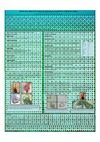Identificador persistente para citar o vincular este elemento:
https://accedacris.ulpgc.es/jspui/handle/10553/5131
| Título: | Axenic cell culture of the seagrass Cymodocea nodosa from cotyledonary tissue | Autores/as: | Zarranz, Maite González-Henríquez, Nieves García-Jiménez, Pilar Robaina Romero, Rafael |
Clasificación UNESCO: | 241719 Fisiología vegetal 241716 Histología vegetal |
Palabras clave: | Cymodocea nodosa Cell culture Seedling Histology |
Fecha de publicación: | 2009 | Resumen: | Plant Tissue Culture, also called “micropropagation”, is the propagation of plants from different tissues (or explants) in a shorter time than conventional propagation, making use of the ability that many plant cells have to regenerate a whole plant (totipotency).There are two alternative mechanisms by which an explant can regenerate an entire plant, namely organogenesis and somatic embryogenesis. Since the last decades, the number of higher terrestrial plants species from which these techniques have been successfully applied has continually increased. However, few attempts have been carried out in marine plants. Previous seagrasses authors have focused their studies on i) vegetative propagation of rhizome fragments as explants in Ruppia maritima, Halophila engelmannii, Cymodocea nodosa and Posidonia oceanica; ii) culture of meristems in Heterozostera tasmanica, C. nodosa or P. oceanica; and iii) culture of germinated seeds on aseptic conditions, in Thalassia testudinum, H. ovalis, P. coriacea, P. oceanica, and H. decipiens. All these studies determine the most adequate culture medium for each species (seawater, nutrients, vitamins, carbon sources, etc...), often supplemented with different plant growth regulators and the necessary conditions for the culture maintenance, such as light and temperature. On the other hand, several studies have previously established protocols for cell or protoplast isolation in the species Zostera marina, Z. muelleri, P. oceanica, and C. nodosa, using shoots collected from natural meadows as original vegetal source, but further cell growth was never accomplished. Due to the absence of somatic embryogenesis or organogenetic studies in seagrasses we wonder: IS THE SUCCESSFUL APPLICATION OF TISSUE CULTURE TECHNIQUES POSSIBLE IN SEAGRASSES? | URI: | https://accedacris.ulpgc.es/handle/10553/5131 |
| Colección: | Póster de congreso |
Visitas
90
actualizado el 16-sep-2023
Descargas
50
actualizado el 16-sep-2023
Google ScholarTM
Verifica
Comparte
Exporta metadatos
Este elemento está sujeto a una licencia Licencia Creative Commons

